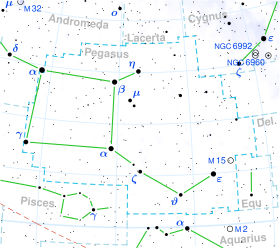Star in the constellation Pegasus
Pi1 Pegasi , Latinized from π1 Pegasi, is a star in the constellation Pegasus . Based upon changes to the proper motion of the visible component, this is a probable astrometric binary .[ 9] apparent visual magnitude of +5.58.[ 2] light years distant from the Sun based on parallax ,[ 1] radial velocity of +5 km/s.[ 4] Ursa Major Moving Group of co-moving stars.[ 10]
π1 Pegasi (right) and π2 Pegasi (left) in optical light The visible component is an aging giant star with a stellar classification of G8IIIb.[ 3] projected rotational velocity of 135 km/s.[ 7] equatorial bulge that is 17% larger than the polar radius.[ 11] shell star , being orbited by a circumstellar shell of cooler gas.[ 12] [ 13] [ 6] [ 6] mass of the Sun . With the supply of hydrogen exhausted at its core , the star has cooled and expanded to 11[ 1] Sun's radius . It is radiating 63[ 1] luminosity of the Sun from its enlarged photosphere at an effective temperature of 4,898 K.[ 1]
References
^ a b c d e f g h i j k l Brown, A. G. A. ; et al. (Gaia collaboration) (August 2018). "Gaia Data Release 2: Summary of the contents and survey properties" . Astronomy & Astrophysics 616 . A1. arXiv :1804.09365 Bibcode :2018A&A...616A...1G doi :10.1051/0004-6361/201833051 Gaia DR2 record for this source at VizieR .^ a b c Anderson, E.; Francis, Ch. (2012), "XHIP: An extended hipparcos compilation", Astronomy Letters , 38 (5): 331, arXiv :1108.4971 Bibcode :2012AstL...38..331A , doi :10.1134/S1063773712050015 , S2CID 119257644 . ^ a b Abt, H. A. (September 1985), "Visual multiples. VIII. 1000 MK types", Astrophysical Journal Supplement Series , 59 : 95– 112, Bibcode :1985ApJS...59...95A , doi :10.1086/191064 ^ a b Gontcharov, G. A. (November 2006), "Pulkovo Compilation of Radial Velocities for 35495 Hipparcos stars in a common system", Astronomy Letters , 32 (11): 759– 771, arXiv :1606.08053 Bibcode :2006AstL...32..759G , doi :10.1134/S1063773706110065 , S2CID 119231169 . ^ a b Takeda, Yoichi; et al. (August 2008), "Stellar Parameters and Elemental Abundances of Late-G Giants", Publications of the Astronomical Society of Japan , 60 (4): 781– 802, arXiv :0805.2434 Bibcode :2008PASJ...60..781T , doi :10.1093/pasj/60.4.781 . ^ a b c d Luck, R. Earle (2015), "Abundances in the Local Region. I. G and K Giants", The Astronomical Journal , 150 (3): 88, arXiv :1507.01466 Bibcode :2015AJ....150...88L , doi :10.1088/0004-6256/150/3/88 , S2CID 118505114 . ^ a b c Massarotti, Alessandro; et al. (January 2008), "Rotational and Radial Velocities for a Sample of 761 HIPPARCOS Giants and the Role of Binarity", The Astronomical Journal , 135 (1): 209– 231, Bibcode :2008AJ....135..209M , doi :10.1088/0004-6256/135/1/209 S2CID 121883397 ^ "pi Peg" . SIMBAD Centre de données astronomiques de Strasbourg . Retrieved 2019-10-13 .^ Eggleton, P. P.; Tokovinin, A. A. (September 2008), "A catalogue of multiplicity among bright stellar systems", Monthly Notices of the Royal Astronomical Society , 389 (2): 869– 879, arXiv :0806.2878 Bibcode :2008MNRAS.389..869E , doi :10.1111/j.1365-2966.2008.13596.x S2CID 14878976 . ^ Schmitt, J. H. M. M.; et al. (March 1990), "X-ray studies of coeval star samples. III. X-ray emission in the UrsaMajor stream.", Astrophysical Journal , 351 : 492– 499, Bibcode :1990ApJ...351..492S , doi :10.1086/168486 ^ van Belle, Gerard T. (March 2012), "Interferometric observations of rapidly rotating stars", The Astronomy and Astrophysics Review , 20 (1): 51, arXiv :1204.2572 Bibcode :2012A&ARv..20...51V , doi :10.1007/s00159-012-0051-2 , S2CID 119273474 . ^ Hauck, B.; Jaschek, C. (February 2000), "A-shell stars in the Geneva system", Astronomy and Astrophysics , 354 : 157– 162, Bibcode :2000A&A...354..157H . ^ Slettebak, A. (September 1986), "H-alpha and near-infrared spectra of late-type Be and A-F-type shell stars.", Publications of the Astronomical Society of the Pacific , 98 : 867– 871, Bibcode :1986PASP...98..867S , doi :10.1086/131836 .
External links

